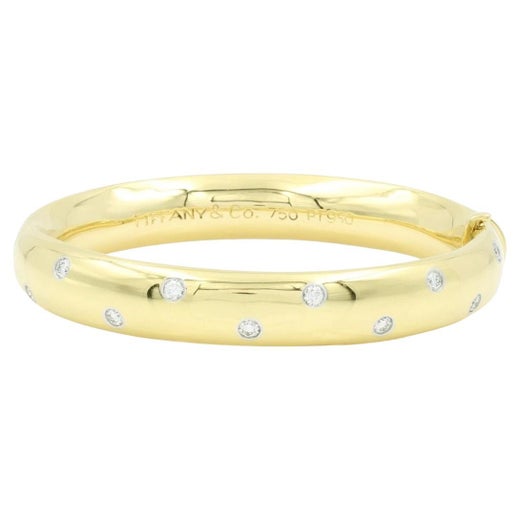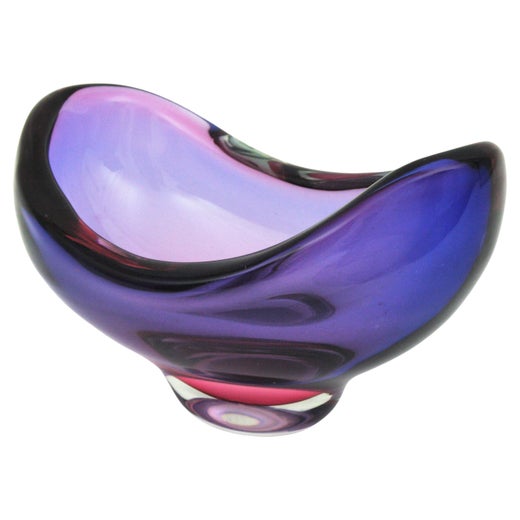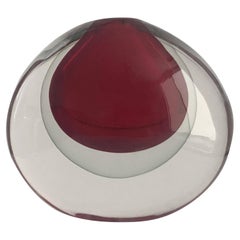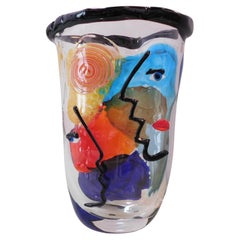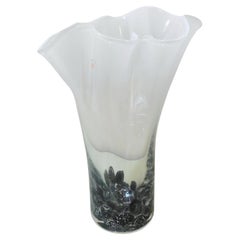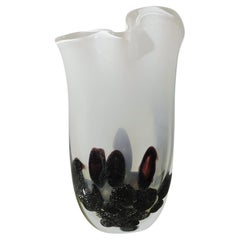Tiffany Heart Shaped Vase by Salviati
About the Item
- Creator:Salviati (Maker),Tiffany & Co. (Retailer)
- Dimensions:Height: 4 in (10.16 cm)Width: 4 in (10.16 cm)Depth: 3 in (7.62 cm)
- Style:Modern (Of the Period)
- Materials and Techniques:
- Place of Origin:
- Period:
- Date of Manufacture:1980s
- Condition:Wear consistent with age and use.
- Seller Location:Los Angeles, CA
- Reference Number:Seller: FABIOLTD G1841stDibs: LU1753223369982
Tiffany & Co.
Tiffany & Co. is one of the most prominent purveyors of luxury goods in the United States, and has long been an important arbiter of style in the design of diamond engagement rings. A young Franklin Delano Roosevelt proposed to his future wife, Eleanor, with a Tiffany ring in 1904. Vanderbilts, Whitneys, Astors and members of the Russian imperial family all wore Tiffany & Co. jewelry. And Jacqueline Kennedy Onassis preferred Tiffany china for state dinners at the White House.
Although synonymous with luxury today, the firm started out rather modestly. Charles Lewis Tiffany and John B. Young founded it in Connecticut as a “stationery and fancy goods emporium” in 1837, at a time when European imports still dominated the nascent American luxury market. In 1853, Charles Tiffany — who in 1845 had launched the company’s famed catalog, the Blue Book, and with it, the firm’s signature robin’s-egg blue, which he chose for the cover — shifted the focus to fine jewelry.
In 1868, Tiffany & Co. gained international recognition when it became the first U.S. firm to win an award for excellence in silverware at the Exposition Universelle in Paris. From then on, it belonged to the pantheon of American luxury brands.
At the start of the Gilded Age, in 1870, Tiffany & Co. opened its flagship store, described as a "palace of jewels" by the New York Times, at 15 Union Square West in Manhattan. Throughout this period, its designs for silver tableware, ceremonial silver, flatware and jewelry were highly sought-after indicators of status and taste. They also won the firm numerous accolades, including the grand prize for silverware at the Paris Exposition of 1878. Among the firm’s glittering creations from this time are masterworks of Art Nouveau jewelry, such as this delicate aquamarine necklace and this lavish plique-à-jour peridot and gold necklace, both circa 1900.
When Charles Lewis Tiffany died, in 1902, his son Louis Comfort Tiffany became the firm’s design director. Under his leadership, the Tiffany silver studio was a de facto design school for apprentice silversmiths, who worked alongside head artisan Edward C. Moore. The firm produced distinctive objects inspired by Japanese art and design, North American plants and flowers, and Native American patterns and crafts, adding aesthetic diversity to Tiffany & Co.’s distinguished repertoire.
Tiffany is also closely associated with diamonds, even lending its name to one particularly rare and exceptional yellow stone. The firm bought the Tiffany diamond in its raw state from the Kimberley mines of South Africa in 1878. Cut to create a 128.54-carat gem with an unprecedented 82 facets, it is one of the most spectacular examples of a yellow diamond in the world.
In a broader sense, Tiffany & Co. helped put diamonds on the map in 1886 by introducing the American marketplace to the solitaire diamond design, which is still among the most popular engagement-ring styles. The trademark Tiffany® Setting raises the stone above the band on six prongs, allowing its facets to catch the light. A lovely recent example is this circa-2000 platinum engagement ring. Displaying a different design and aesthetic (but equally chic) is this exquisite diamond and ruby ring from the 1930s.
Find Tiffany & Co. jewelry, serveware and decorative objects for sale on 1stDibs.
Salviati
Not only did Salviati support the revival of Venice’s flagging Murano glass industry in the 19th century, but the company also became world-renowned for its innovative glassmaking techniques, revolutionizing the art of mosaics and glassware design.
The story of Salviati glass begins with Vicenza-born lawyer and entrepreneur Antonio Salviati. His love of Murano glass art and mosaics inspired him to establish his own mosaic and glass manufacturing firm, the Salviati Dott. Antonio fu Bartolomeo company, in Venice in 1859. Glassmakers in the region had been weathering a dismal political climate and growing competition in neighboring countries, and Salviati had initially hoped to revive Murano glassmaking in order to restore deteriorating mosaics in local cathedrals.
In 1864, Salviati exhibited a monumental glass mosaic at the “First Glassmakers’ Exhibition,” which won the gold medal. His award-winning mosaic solidified his company’s reputation as a first-rate glassmaker, which soon drew the attention of international investors, particularly investors from Great Britain.
In 1866, Salviati and C. opened in London with the support of historian William Drake and diplomat Sir Austen Henry Layard. Meanwhile, the Salviati company established its headquarters on the Rio dei Vetrai in Murano.
Throughout the late 1800s, Salviati and C. expanded its production to include household glassware and serveware and decorative objects such as cups, glasses, amphoras and vials. Salviati also received commissions to produce mosaics for St Paul’s Cathedral and the Houses of Parliament in London, the Paris Opera House and the Viceroy of Egypt’s Palace in Alexandria.
After Antonio Salviati died in 1890, his sons Giulio and Silvio took over the company. The Barovier family — a dynasty that stretches as far back as 1295 — bought the manufacturer in 1883, and a glass master named Maurizio Camerino, who had honed his skills at Salviati, was appointed to lead the company. Camerino’s children took the reins following the glass master’s death in 1931 and launched a successful lighting line of table lamps and chandeliers after World War II.
Throughout the 20th century, Salviati participated in several Venice Biennale exhibitions from 1958 to 1972. In 1962, the company was awarded the Compasso d’Oro prize for the Marco vase, designed by architect Sergio Asti.
Since its acquisition by the Umana group in 2015, Salviati has collaborated with numerous renowned designers such as Federico Peri, Davide Bruno, Renzo Stellon, Alberto Lago and Anna Gili. Salviati's pieces can be found in the collections of the Museum August Kestner in Hanover, Germany, the Museum of Modern Art and Corning Museum of Glass in New York, the Eretz Museum in Tel Aviv, Israel, and the Murano Glass Museum in Venice.
Find antique Salviati glass that includes bowls, vases, lighting and more.
You May Also Like
Vintage 1980s Italian Other Vases
Art Glass
Late 20th Century Italian Vases
Glass
Vintage 1970s Italian Modern Vases
Murano Glass
Vintage 1980s Italian Modern Vases
Murano Glass
Vintage 1950s Unknown Vases
Porcelain
Early 2000s Italian Modern Vases
Glass
21st Century and Contemporary Italian Modern Vases
Glass
21st Century and Contemporary Italian Modern Vases
Glass
21st Century and Contemporary Italian Modern Vases
Glass
Vintage 1970s Italian Mid-Century Modern Vases
Murano Glass
More From This Seller
View AllLate 20th Century Italian Modern Vases
Blown Glass, Murano Glass
20th Century Italian Modern Vases
Murano Glass
20th Century Italian Modern Vases
Murano Glass
20th Century Italian Modern Vases
Murano Glass
20th Century Italian Modern Vases
Murano Glass
20th Century Italian Modern Vases
Murano Glass
Recently Viewed
View AllRead More
Unexpected Gems Were All Over the Latest High-Jewelry Collections
Diamonds and sapphires still played a starring role, but less popular stones popped up too.
15 Scintillating Jewelry Watches to Elevate Your Holiday Style
Watchmakers have tucked their movements into all manner of precious baubles, from lapel pins to cocktail rings. The result is dazzling, wearable art that will get you to the party on time.
